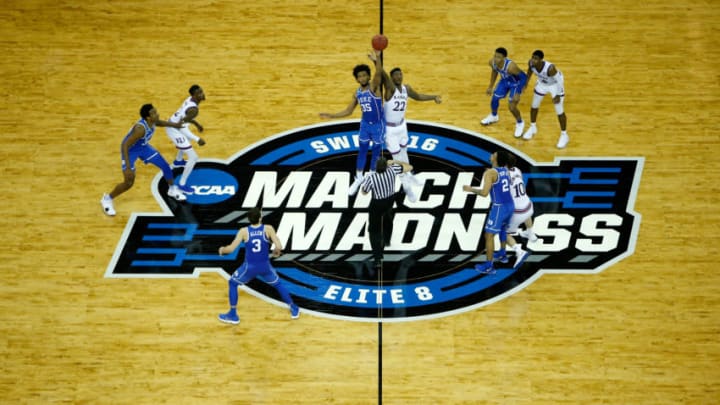The One-And-Done topic has been at the forefront of college basketball for many years, but regardless of what happens to the rule, Duke Basketball will still thrive.
The NCAA Division I Council will meet Wednesday to make legislative and policy recommendations to the Division I Board. Among the recommendations the Division I Council will make will undoubtedly be the findings of the acclaimed Rice Report. The report, led by Condoleezza Rice, recommends the end of the One-And-Done citing, “One-And-Done has played a significant role in corrupting and destabilizing college basketball, restricting the freedom of choice of players, and undermining the relationship of college basketball to the mission of higher education.”
On the heels of an FBI investigation that revealed numerous payments from the sports agency ASM to dozens of collegiate players, the Rice Report aimed to detail the level of corruption and the ways to fix college basketball. Glaringly left out of the report was player compensation. Instead, the report focuses on the immorality of the business of college basketball and calls upon NCAA officials to be more transparent when dealing with student-athletes while failing to address the source of the FBI investigation itself. What’s more is that the FBI investigation revealed that upperclassmen had received payments. If the issue goes beyond those that are required to be in college to student-athletes that are not, then isn’t the issue much larger than One-And-Done.
More from Ball Durham
- Duke basketball: The architect behind digital dominance
- Duke basketball prioritizing frontcourt prospects in 2025
- Duke basketball: Unmasking the hate for the Blue Devils
- Duke basketball: Countdown to Craziness lands another huge visitor
- Duke basketball fills final open scholarship
One-And-Done is a smokescreen for player compensation. It is a rule instituted by the NBA to give general managers and scouts one more year of information before drafting a player. To say, One-And-Done has corrupted and destabilized college basketball is untrue. The NCAA has always been corrupt. The second of these schools made their living on the backs of unpaid students is the second the NCAA became a dishonest industry.
If what college basketball is selling is the product, then One-And-Done has had little effect. For the majority of Division I college basketball programs, One-And-Done hasn’t changed anything at all. Since 1980, 19 programs have won the NCAA championship. There is over 300 Division I basketball programs and more than 90% of them haven’t sniffed a championship in the last 38 years. The same teams that won then, win now. The biggest impact of One-And-Done has been that for one year LSU’s TV ratings went up when everybody wanted to see Ben Simmons.
In reality, there are only two programs that have been changed by One-And-Done. It happens that these two programs are two of the most historic programs in history: Duke and Kentucky. The only difference between now and then is that Christian Laettner doesn’t stick around long enough to hit the shot to beat Kentucky in the 1992 Final Four. Duke and Kentucky are still in the Final Four just with an average age of 19 instead of 20.
When we talk about One-And-Done we are talking about these two schools. There will be Kevin Durant’s who go to Texas and Markelle Fultz’s who go spend a year at Washington, but no two schools have embraced the One-And-Done like Duke and Kentucky. No other schools consistently overhaul their roster to make way for the next batch of stellar recruits.
Still, Duke and Kentucky don’t win every year. One-And-Done hasn’t tipped the scales drastically in favor of one program over another. In fact, Duke had more success pre-One-And-Done. From 2000-2010, Duke won eight ACC championships and two NCAA championships. Although the rule was implemented in 2006, the true One-And-Done age at Duke did not begin until Kyrie Irving enrolled in 2011. In the seven seasons since Duke has just as many Round of 64 losses as ACC championships: 2.
Duke, Kentucky, Villanova, North Carolina, Connecticut, all have had sustained success during the One-And-Done Era. All of these teams had sustained success before the One-And-Done rule. The top high school players in the country go to the schools with the highest profile year in and year out, and that won’t ever change. Paying the student-athletes won’t change that either. If a player is good enough to play at Duke, he plays at Duke. He doesn’t go play in the WAC
The product the NCAA produces will always be entertaining because of the very nature of its participants. These are young men, often living away from home for the first time, playing on the biggest stages the U.S. has to offer, and in front of millions of people. As young men, they make mistakes and that is exciting. One of the most memorable plays in sports was Chris Weber calling a timeout he didn’t have!
Regardless of what the future holds for the NCAA, college basketball will be fine. If the One-And-Done rule is ended, college basketball won’t change. Even if the NCAA decides to compensate it’s players, which they should if they are truly serious about ending this kind of terrible corruption, college basketball won’t change.
